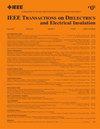不同环境条件下Cu₂S活性对油纸绝缘介电性能的影响
IF 3.1
3区 工程技术
Q2 ENGINEERING, ELECTRICAL & ELECTRONIC
IEEE Transactions on Dielectrics and Electrical Insulation
Pub Date : 2025-04-22
DOI:10.1109/TDEI.2025.3563165
引用次数: 0
摘要
本文研究了不同环境条件下,二苄基二硫化物(DBDS)对变压器系统用压板老化和绝缘性能的影响。虽然DBDS在老化的初始阶段起到抗氧化剂的作用,但它的热分解会产生腐蚀性的硫化合物,从而导致油和压板绝缘材料的化学降解。这些硫在变压器中的相互作用导致硫化铜(Cu2S)的形成,随后扩散到压板中,改变其热学和电气特性。激光诱导击穿光谱(LIBS)证实了单质铜和硫的存在,表明了Cu2S在压板中的扩散。研究了压板的热阱密度与DBDS和环境气体对介电参数的影响之间的关系。热阱密度是影响材料电学性能的关键参数,影响电荷的储存和耗散过程。此外,使用激光闪光分析(LFA)对老化板的散热性能进行了评估,突出了空气和氮气老化条件下热行为的差异。本文章由计算机程序翻译,如有差异,请以英文原文为准。
Impact of Cu₂S Activity on Dielectric Properties of Oil-Paper Insulation Under Different Ambient Conditions
This study investigates the impact of Dibenzyl Disulfide (DBDS) on the aging and insulating properties of the pressboard used in transformer systems under varying ambient conditions. While DBDS acts as an antioxidant during the initial stages of aging, its thermal decomposition generates corrosive sulfur compounds that contribute to the chemical degradation of both the oil and pressboard insulation. These sulfur interactions in the transformer lead to the formation of copper sulfide (Cu2S), which subsequently diffuses into the pressboard, altering its thermal and electrical characteristics. Laser-induced breakdown spectroscopy (LIBS) is employed to confirm the presence of elemental copper and sulfur, indicating the Cu2S diffusion in the pressboard. The study correlates the heat trap density of the pressboard with the effects of DBDS and ambient gases on dielectric parameters. Heat trap density is identified as a critical parameter influencing the material’s electrical behavior, affecting charge storage and dissipation processes. Additionally, heat dissipation properties of the aged pressboard are evaluated using laser flash analysis (LFA) highlighting differences in thermal behavior under air and nitrogen aging conditions.
求助全文
通过发布文献求助,成功后即可免费获取论文全文。
去求助
来源期刊
CiteScore
6.00
自引率
22.60%
发文量
309
审稿时长
5.2 months
期刊介绍:
Topics that are concerned with dielectric phenomena and measurements, with development and characterization of gaseous, vacuum, liquid and solid electrical insulating materials and systems; and with utilization of these materials in circuits and systems under condition of use.

 求助内容:
求助内容: 应助结果提醒方式:
应助结果提醒方式:


